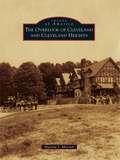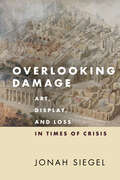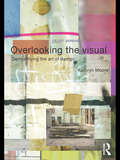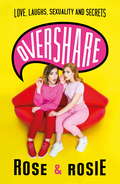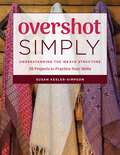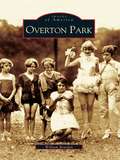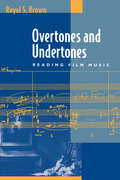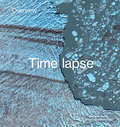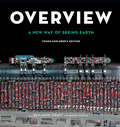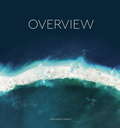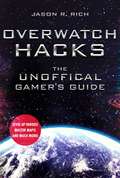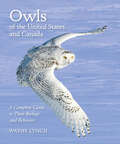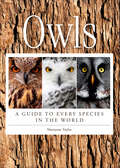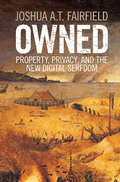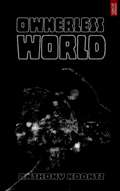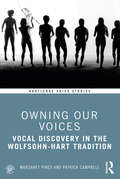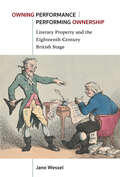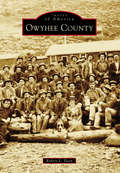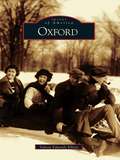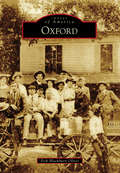- Table View
- List View
Overlook of Cleveland and Cleveland Heights, The
by Marian J. MortonRailroad tycoon turned real estate developer Patrick Calhoun named the premier residential boulevard of his Euclid Heights allotment the Overlook because of its location high on a bluff overlooking Case School of Applied Science, Western Reserve College, Lake Erie, and the city of Cleveland. By 1910, the boulevard was lined with the mansions of Cleveland's wealthy and powerful. Today, although traces of the Overlook's glory days remain, most of its great mansions are gone, replaced by apartment houses and the dormitories and fraternity houses of Case Western Reserve University. This is the story of that transformation.
Overlooking Damage: Art, Display, and Loss in Times of Crisis
by Jonah SiegelWhat does it mean to look? How does looking relate to damage? These are the fundamental questions addressed in Overlooking Damage. From the Roman triumph to the iconoclasm of ISIS and the Taliban to the aerial views of looted landscapes and destroyed temples visible on Google, the relationship between beauty and violence is far more intimate than we sometimes acknowledge. Jonah Siegel makes the daring argument that a thoughtful reaction to images of damage need not stop at melancholy, but can lead us to a new reckoning. Would the objects we admire be more beautiful if they were not injured or displaced, if they did not remind us of unbearable violence? Siegel takes up writers from the time of the French Revolution to today who have reacted to the depredations of revolutionary iconoclasm, imperial looting, and industrial capitalism, and proposes that in these authors we may find resources with which to navigate our contemporary situation. Deftly bringing the methods of literary studies to bear on important debates in the study of heritage, archaeology, and visual culture, Overlooking Damage reflects on the ways in which concepts of beauty intersect with periods of epochal violence in an attempt to resist the separation of broken things from the worlds in which they have come to be embedded.
Overlooking the Visual: Demystifying the Art of Design
by Kathryn MooreMaking tangible connections between theory and practice, ideas and form, this book encourages debate about the artistic, conceptual, and cultural significance of the way things look. What are the metaphysical concepts at the heart of design education, theory, and philosophy? Why do we assume that design is impossible to teach? This book challenges the traditional foundations of perception and takes an imaginative, radical approach, setting itself apart from the traditions of analytical philosophy, evolutionary psychology, and phenomenology which underpin much of current design theory and discourse. The new definition of perception produces startling consequences for conceptions of language, intelligence, meaning, the senses, emotions and subjectivity. This is an innovative, fresh view on design and how we can improve it for both practitioners and students in the architecture and design fields as well as philosophers.
Overshare: Love, Laughs, Sexuality and Secrets
by Rose Ellen Dix Rosie SpaughtonRose and Rosie are known for their candid and hilarious YouTube videos... but now they are taking oversharing to a whole new level. Discussing sexuality, revealing secrets and empowering others, OVERSHARE is a book packed with Rose and Rosie's unique take on friendships, fame, mental health and LGBT issues.As visibly out members of the LGBT community, they open up about their own experiences, both together and as individuals, and have written this book in the hope that it gives strength to those who have faced similar difficulties. They are spreading a message of positivity and inclusivity, and want everyone to feel comfortable in their own skin, no matter what their sexuality. Delve deep into the unfiltered highs and lows of Rose and Rosie's life: family relationships, secrets of a happy marriage, struggles with OCD and anxiety, finding love and navigating the world as a gay couple. Get ready to laugh, cry, cringe and OVERSHARE.
Overshare: Love, Laughs, Sexuality and Secrets
by Rose Ellen Dix Rosie SpaughtonRose and Rosie are known for their candid and hilarious YouTube videos... but now they are taking oversharing to a whole new level. Discussing sexuality, revealing secrets and empowering others, OVERSHARE is a book packed with Rose and Rosie's unique take on friendships, fame, mental health and LGBT issues.As visibly out members of the LGBT community, they open up about their own experiences, both together and as individuals, and have written this book in the hope that it gives strength to those who have faced similar difficulties. They are spreading a message of positivity and inclusivity, and want everyone to feel comfortable in their own skin, no matter what their sexuality. Delve deep into the unfiltered highs and lows of Rose and Rosie's life: family relationships, secrets of a happy marriage, struggles with OCD and anxiety, finding love and navigating the world as a gay couple. Get ready to laugh, cry, cringe and OVERSHARE.
Overshot Simply: Understanding the Weave Structure 38 Projects to Practice Your Skills
by Susan Kesler-SimpsonOvershot is perhaps the most iconic weaving technique--think antique coverlets and fancy table runners--yet many weavers are intimidated by its complex-looking structure. But it doesn't have to be difficult! In this book, Susan Kesler-Simpson makes overshot approachable by breaking it down piece by piece so that the weaver understand how it works, and then she puts it all back together so that weavers will have the confidence to make their own overshot patterns or to try any of the 38 overshot projects she has designed for the book. Weavers will learn:to understand overshot as a derivative of twillto understand the tie-up, placement of tabby in the tie-up, threading, and treadlinghow to choose threads for overshothow to use borders in your designshow to set up the loom for overshothow to work an overshot gampProjects include:BlanketsShawlsScarvesChristmas ornamentsTable runnersPlacematsNapkinsOthers"Susan&’s explanations are to the point and easy to understand. When you read through the chapters, it&’s as if Susan is sitting there with you, telling you in a friendly voice how to weave overshot step by step."--excerpt from the Foreword by Tom Knisely
Oversize Fashion Crochet: 6 Cozy Cardigans, Pullovers & Wraps Designed with Maximum Style and Ease
by Salena BacaGet ready for cool weather, fast!You'll be ready to cozy up in no time with these 6 crochet designs made with bulky yarn and big hooks. Designs include pullovers, cardigans, ponchos, and wraps in easy-to-wear, popular oversized fit.
Overton Park (Images of America)
by William BeardenOverton Park in Memphis, Tennessee, is a gem in the midst of a sprawling Southern city. In 1900, as Memphis emerged from bankruptcy and yellow fever epidemics, the Progressive movement encouraged Memphians to rely on the government for a better quality of life. The Memphis Park Commission, chartered that year, purchased 342 acres of land at the eastern edge of the city. Landowner Overton Lea of Nashville earned $110,000 from the sale. George Kessler was hired to build Overton Park, and the intervening years saw such amenities as the city's first zoo, the Brooks Museum of Art, the Overton Park Shell (the site of Elvis Presley's first public performance), Memphis College of Art, war memorials, and hiking trails through the world's only old-growth forest in an urban setting.
Overtones and Undertones: Reading Film Music
by Royal S. BrownSince the days of silent films, music has been integral to the cinematic experience, serving, variously, to allay audiences' fears of the dark and to heighten a film's emotional impact. Yet viewers are often unaware of its presence. In this bold, insightful book, film and music scholar and critic Royal S. Brown invites readers not only to "hear" the film score, but to understand it in relation to what they "see."Unlike earlier books, which offered historical, technical, and sociopolitical analyses, Overtones and Undertones draws on film, music, and narrative theory to provide the first comprehensive aesthetics of film music. Focusing on how the film/score interaction influences our response to cinematic situations, Brown traces the history of film music from its beginnings, covering both American and European cinema. At the heart of his book are close readings of several of the best film/score interactions, including Psycho, Laura, The Sea Hawk, Double Indemnity, and Pierrot le Fou. In revealing interviews with Bernard Herrmann, Miklós Rósza, Henry Mancini, and others, Brown also allows the composers to speak for themselves. A complete discography and bibliography conclude the volume.
Overview Timelapse: How We Change the Earth
by Benjamin Grant Timothy DoughertyA stunning and unique collection of satellite images of Earth that offer an unexpected look at humanity, derived from the wildly popular Daily Overview Instagram project.Inspired by the &“Overview Effect&”—a sensation that astronauts experience when given the opportunity to look down and view the Earth as a whole—the breathtaking, high definition satellite photographs in OVERVIEW offer a new way to look at the landscape that we have shaped. More than 200 images of industry, agriculture, architecture, and nature highlight incredible patterns while also revealing a deeper story about human impact. This extraordinary photographic journey around our planet captures the sense of wonder gained from a new, aerial vantage point and creates a perspective of Earth as it has never been seen before.
Overview, Young Explorer's Edition: A New Way of Seeing Earth
by Sandra Markle Benjamin GrantDiscover Earth as you've never seen it before, in this stunning and unique collection of satellite images that offer an unexpected look at our planet. A perfect gift for young National Geographic fans and atlas enthusiasts!When astronauts look down at our planet and see its vibrant surface shining against the blackness of space, they experience the Overview Effect--a sense of awe, an awareness that everything is interconnected, and an overwhelming desire to take care of our one and only home.Overview: Young Explorer's Edition, newly adapted for young readers from the adult book Overview, captures this sense of wonder and shares it with readers without having to leave the ground. Extraordinary aerial photographs reveal Earth's natural beauty and show the surprising, fascinating, and destructive ways humans have impacted our environment. This eye-opening visual journey will forever change the way we see our home planet.
Overview: A New Perspective of Earth
by Benjamin GrantA stunning and unique collection of satellite images of Earth that offer an unexpected look at humanity, derived from the wildly popular Daily Overview Instagram project.Inspired by the "Overview Effect"--a sensation that astronauts experience when given the opportunity to look down and view the Earth as a whole--the breathtaking, high definition satellite photographs in OVERVIEW offer a new way to look at the landscape that we have shaped. More than 200 images of industry, agriculture, architecture, and nature highlight incredible patterns while also revealing a deeper story about human impact. This extraordinary photographic journey around our planet captures the sense of wonder gained from a new, aerial vantage point and creates a perspective of Earth as it has never been seen before.From the Hardcover edition.
Overwatch Hacks: The Unoffical Gamer's Guide
by Jason R. RichTargeted to gamers between the ages of eight and twelve, this full-color, unofficial, ninety-six-page strategy guide will cover the PlayStation 4, Xbox One, and PC editions of Blizzard Entertainment’s mega-popular game Overwatch: Game of the Year Edition. Each section of the book will feature detailed, yet easy-to-understand tips and strategies, along with screenshots that will help readers quickly master the game when experiencing the Competitive Play (multiplayer) mode. Overwatch Hacks will offer details about each of the game’s 26 core heroes, and describe each hero’s unique strengths, weaknesses, abilities, and ultimate abilities. Since Overwatch is all about multi-player team play, an emphasis on what each hero’s abilities are best suited for—related to offense, defense, tank, or support—will be covered, as will how a player should adapt their overall gameplay strategy based on which hero they choose to control, and what role they’ll be playing as a member of their team. This game is very much about team collaboration, communication, and coordination, and the tips and strategies outlined in this book will focus heavily on these elements of the game. Readers will also discover what they need to know about the maps and locations where battles occur, and learn how to adapt their strategy based on their location within the game in order to complete location-specific objectives. Finally, this guide will offer tips for best utilizing customization options and loot. Whether a gamer is playing with AI controlled team members, random online players, or their best friends, the reader will go into each battle and adventure with the knowledge and strategies needed to achieve victory. As a team-based shooter set in the near future, Overwatch was one of the fastest games in history to attract more than 30 million active players. It continues to win awards and be among the most popular multiplayer games available for the PlayStation 4, Xbox One, and Windows PC platforms.
Owl Be Home for Christmas: A Meg Langslow Mystery (Meg Langslow Mysteries #26)
by Donna AndrewsNew York Times bestselling author Donna Andrews returns with another Meg Langslow mystery written "firmly in the grand tradition of Agatha Christie's Christmas books" (Toronto Globe and Mail). The 26th book and the sixth Christmas mystery in the Meg Lansglow series, Owl Be Home for Christmas is yet another wonderfully merry and funny book from New York Times bestselling author Donna Andrews.It's a few days before Christmas, and Meg's grandfather is hosting a scientific conference on owls at the Caerphilly Inn. Most of the family are there, helping out in one capacity or another, including Meg's grandmother, Cordelia--invited by Grandfather in rare gesture of peace-making, to share her expertise on rehabilitating large birds, including owls. An unexpectedly severe snow storm traps the conference-goers in the hotel, and one of the visiting ornithologists is murdered. Even if Caerphilly is able to clear the roads in time, Chief Burke doesn't want the various suspects to scatter to half a dozen continents before he identifies the killer, so there's a very real possibility that none of them will make it home for Christmas . . . at least not unless Meg comes to the rescue.Full of intrigue and snow, this Christmas mystery will take readers home to Caerphilly for Christmas.
Owls of the United States and Canada: A Complete Guide to Their Biology and Behavior
by Wayne LynchNamed One of the Best Reference Books of 2007 by Library JournalThere is no group of birds more mysterious and fascinating than owls. The loudmouths of the raptor world, they peep, trill, toot, bark, growl, shriek, whistle, chittle, whoop, chuckle, boom, and buzz. Indeed, very few actually "hoot." They have become the stuff of lore and legend—from the Roman myth that an owl foot could reveal secrets to the First Nations belief that an owl feather could give a newborn better night vision. But the truth about owls is much more exciting.In this gorgeous book, celebrated natural history writer and wildlife photographer Wayne Lynch reveals the secrets of these elusive species with stunning photographs, personal anecdotes, and accessible science. The photos alone are masterpieces. Unlike most published owl photos, which are portraits of birds in captivity, the vast majority of these were taken in the wild—a product of the author-photographer's incredible knowledge and patience. Lynch complements the photos with a wealth of facts about anatomy, habitat, diet, and family life. For each of the nineteen species that inhabit Canada and the United States, he provides a range map and a brief discussion of its distribution, population size, and status. Lynch debunks myths about owls' "supernatural" powers of sight and hearing, discusses courtship rituals, and offers personal tips for finding owls in the wild. From the great horned to the tiny elf owl, this amazing volume captures the beauty and mystery of these charismatic birds of prey.
Owls: A Guide to Every Species in the World
by Marianne TaylorDiscover the fascinating and mysterious world of owls with this stunning full-color, encyclopedic visual guide that explores all 225 known species, packed with maps, photographs, illustrations, informative scientific details, and a bonus 35½" x 12" accordion poster illustrated with the true-to-size wing span of the largest owl, overlayed with the wing span of the smallest owl and several owls in-between.Humans have long been fascinated by owls. From prehistoric cave paintings to popular modern children’s stories, these magnificent predators have been seen as harbingers of good fortune and impending disaster, as icons of fear and wisdom, and as the powerful sidekicks of magic-makers, including the beloved Harry Potter. Scientists have faced tremendous challenges trying to document the lives of these solitary, nocturnal, and highly elusive creatures. New species are still being discovered, as are new insights into the habits of even the most familiar varieties. Visually spectacular and authoritative, Owls includes full descriptions and maps of key viewing locations for all 225 owl species in the world, and is illustrated with drawings and stunning full-color images from some of the leading wildlife photographers from around the world which capture these birds’ breathtaking beauty and power. The book also features a special section on the art of hiding—a highly honed skill set of the owl.Throughout, Marianne Taylor provides a wealth of detail on each type of bird’s hunting and breeding behavior, habitat, and conservation. Inside, are dozens of fun facts, such as: Only nineteen of the 225 known species of owls are found in North America;Owls can be found on all continents except Antarctica;Owls, like humans, have binocular vision;Owls cannot turn their eyes, but are able to rotate their heads up to 270 degrees;Owls are carnivorous and are known to eat rodents, small mammals, nocturnal insects, fish, and other birds. Lavishly illustrated and educational, this breathtaking volume is essential for readers interested in natural science, devout birders, professional ornithologists, and all owl lovers.
Own It!
by Tabatha CoffeyTabatha is back to share her secrets of business success . . .With her characteristic savvy expertise and no-nonsense advice, the perfectly coiffed celebrity hairstylist, Tabatha Coffey, returns with her second book, teaching readers that the secret of success is taking charge--of your priorities, your future, and your life. Fans of her hit show, Tabatha Takes Over, value Tabatha's sound approach to overhauling failing businesses, and now, in Own It!, she takes to the page to reach out to anyone with a dream: whether you're just beginning, revamping your career, or starting your own enterprise.Sharing her blunt but rock-solid wisdom, Tabatha provides tips for every aspect of business--from entrepreneurship, to customer service, to management--as well as on the home front, to help women seeking to balance their family lives with their careers. Filled with stories about real people who have faced challenging transitions, in addition to anecdotes from Tabatha's own experiences, this book reveals, through her unflinching honesty, Tabatha's commitment to the dreams and goals of her readers, and her never-say-never attitude when it comes to bringing them to life. Success is the result when you Own It! in all aspects of your life, and Tabatha breaks it down step-by-step as your straight-shooting personal coach to show you how it's done.
Own Your Space: Attainable Room-by-Room Decorating Tips for Renters and Homeowners
by Alexandra GaterDIY YouTuber Alexandra Gater shows you how to creatively, inexpensively, and beautifully decorate your space in this inviting and accessible definitive guide to décor ideas for renters and new homeowners alike."Alexandra Gater represents a new generation of apartment therapists who are teaching people how to make a great home at any size with any budget. Her new book is an absolute gift that is not only beautiful and approachable, it's so comprehensive you'll read it, refer to it and keep it under your pillow at night." —Maxwell Ryan, founder of Apartment TherapyHave you ever wondered what to do about the “Renter Beige” walls in your apartment? Have you ever thought you’d wait to upgrade that sofa from your grandparents’ basement until you had a place of your own—and then found yourself spiraling with questions like, “Will I ever own a house?” Have you bought a new home—but now have little money left over to spruce it up? And how can you make those outdated appliances and cabinets in your kitchen look better without breaking your budget?Alexandra Gater is here to help.Through her online home decorating series, the YouTube star and décor expert has taught millions how to transform their spaces into the homes of their dreams. Whether struggling with the limits of living in a rental—how do you hang things without putting holes in the wall?—or living in a new home—how can you make that outdated backsplash work for you?—Alexandra has the answer. In Own Your Space, she offers tips and tricks covering everything from making your home smell better to essential kitchen utensils. And best of all, you get to know her better along the way.Gorgeously designed, full of practical advice, DIY, and fun anecdotes, and packed with approximately 300 four-color photographs, Own Your Space will help you turn your apartment or starter house into the place you want it to be .
Owned: Property, Privacy, and the New Digital Serfdom
by Fairfield Joshua A. T.According to the important American poet John Ashbery, "To read Fairfield Porter is to rediscover art through the eyes of someone whose intuitive love and understanding of it has been matched by few contemporaries," while fellow New York School poet Barbara Guest wrote, "Blunt, intuitive, scholarly, inspired--I believe no other critic has so tackled the meaning of twentieth century art, has tightened our vision of it. " Known as one of America's finest and most influential painters, Fairfield Porter (1907-1975) was also a prolific and highly insightful art critic. His writing not only reflects the independent, original mind that presided over his own visual works, but also covers an extraordinary period in American art, in which he played the double role of protagonist and witness. This new edition of Art in Its Own Terms restores to print a key statement in the ongoing discussion between Modern art and its past, as Porter reviews such figures as de Kooning, Johns, Cornell, Rodin, Cezanne, Leonardo and many others. Equally seminal are his considerations of the relations between art and science and art and politics. Rackstraw Downes' introduction beautifully sets the stage for this indispensable and wide-ranging volume.
Ownerless World
by Anthony KoontzThis is a book about power, politics, sex, religion and science. It presents a future world where the economy is declining and various corporations are fighting each other for global power. Meanwhile, a revolutionary new technology is being born: an artificial deity willing to help people defeat those who are controlling capital and the planet. It’s everything conspiracy theories never talk about. If God doesn’t exist, you must create Him.
Owning Our Voices: Vocal Discovery in the Wolfsohn-Hart Tradition (Routledge Voice Studies)
by Patrick Campbell Margaret PikesOwning Our Voices offers a unique, first-hand account of working within the Wolfsohn-Hart tradition of extended voice work by Margaret Pikes, an acclaimed voice teacher and founder member of the Roy Hart Theatre. This dynamic publication fuses Pikes’ personal account of her own vocal journey as a woman within this, at times, male-dominated tradition, alongside an overview of her particular pedagogical approach to voice work, and is accompanied by digital footage of Pikes at work in the studio with artist-collaborators and written descriptions of scenarios for teaching. For the first time, Margaret Pikes’ uniquely holistic approach to developing the expressive voice through sounding, speech, song and movement has been documented in text and on film, offering readers an introduction to both the philosophy and the practice of Wolfsohn-Hart voice work. Owning Our Voices is a vital book for scholars and students of voice studies and practitioners of vocal performance: it represents a synthesis of a life’s work exploring the expressive potential of the human voice, illuminating an important lineage of vocal training, which remains influential to this day.
Owning Performance | Performing Ownership: Literary Property and the Eighteenth-Century British Stage
by Jane WesselIn 1710, England’s first copyright law gave authors the ability to own their works, but it was not until 1833 that literary property law was extended to protect dramatic performance. Between these dates, generations of playwrights grappled for control over their intellectual property in a cultural and legal environment that treated print differently from performance. As ownership became a central concern for many, actors fought to possess their dramatic parts exclusively, playwrights struggled to control and profit from repeat performances of their works, and managers tried to gain a monopoly over the performance of profitable plays. Owning Performance follows the careers of some of the 18th century’s most influential playwrights, actors, and theater managers as they vied for control over the period’s most popular shows. Without protection for dramatic literary property, these figures developed creative extra-legal strategies for controlling the performance of drama—quite literally performing their ownership. Their various strategies resulted in a culture of ephemerality, with many of the period’s most popular works existing only in performance and manuscript copies. Author Jane Wessel explores how playwrights and actors developed strategies for owning their works and how, in turn, theater managers appropriated these strategies, putting constant pressure on artists to innovate. Owning Performance reveals the wide-reaching effects of property law on theatrical culture, tracing a turn away from print that affected the circulation, preservation, and legacy of 18th century drama.
Owyhee County
by Robert L. DeenThe sprawling high desert wilderness of southwestern Idaho was virtually unknown to whites in 1863, when Mike Jordan and a band of placer miners dipped their pans into the creek that bears his name and found gold. The electrifying news spread, and the people came. Towns sprang up overnight on the mountaintops. Some disappeared almost as quickly as they had appeared. "Men needed to work the mines!" cried Idaho's newspapers. The word went out, and the miners came from Nevada, California, Colorado, and across the West. Soon the great mines of War Eagle Mountain rivaled Nevada's fabled Comstock Lode. With the exception of Silver City, one of America's largest intact ghost towns, the boomtowns, as well as the mines, are gone; however, descendants of the miners remain. Owyhee County is the size of Delaware and Connecticut combined--7,679 square miles--with a population of only 11,500. It is a rarely visited land of few roads and fewer people, sagebrush desert, deep basalt canyons, romantic vistas, and mysterious mountains that still hide their gold and silver.
Oxford
by Valerie Edwards ElliottIn the early 1800s, a wooded hilltop in southwestern Ohio became the site for Miami University and the town of Oxford. Miami was named for the area's Native American inhabitants and Oxford for the university town in England. By mid-century, Oxford was a well-established academic community featuring a university plus a men's theological seminary and three educational institutions for women. Oxford depicts the town's historic ties to higher education and its notable people, including U.S. President Benjamin Harrison and his wife Caroline Scott, author William Holmes McGuffey, and apiarist Lorenzo Langstroth. Today's Oxford continues to offer superior educational opportunities, athletic events, and cultural activities.
Oxford (Images of America)
by Erik Blackburn OliverThe notion that the stateliest of oaks germinates from an altogether miniscule acorn has special meaning for the community of Oxford, Georgia, whether used literally to describe the "Prince of the Forest" or metaphorically depict large and long serving families or the birth of a great university. Emory College was rooted in the soils of Oxford for 80 years, growing in fits and starts until 1919, when, with relative suddenness, it was transplanted to Atlanta. In the wake of that move, the community shrank from a Methodist stronghold to an institutional afterthought. Yet, both the community and the campus endured and thrived again, as both old and new families put down fresh roots and engendered a deep sense of place, fellowship, service, and celebration.
